As I work on putting my garden to bed for the winter I’m realizing how much I like working with open raised beds. I’ve been working with them for nearly thirty years. Soon after starting my Wisconsin garden in 1986, I knew that, for me at least, maintaining a relatively large garden did not require power equipment and I gave away my rototiller. All the work in my raised bed garden is done with hand tools.
I’ve become an advocate for growing food intensively in open raised beds. It’s a great way to grow a lot of food without a lot of outside inputs. Open raised beds have been around about as long as people have been growing food, but the method I’ve developed and refined over the years is based mostly on the well-known book HOW TO GROW MORE VEGETABLES by John Jeavons. The book was my rudimentary instructor, but I’ve modified things to suit my garden and what works well for me.
The overview of the system is that instead of planting crops in rows, the garden is composed of beds of loose soil. The gardener only walks in the paths surrounding the beds, thus soil compaction is nearly eliminated. The beds are seeded or planted so that as the crops mature they cover the bed with leaf growth which helps suppress weeds. Plants spaced in a pattern covering the entire width of the beds yield far larger harvests per area than possible by traditional planting in rows.
As I prepared the beds for winter this year several things that make this system work so well became very apparent. Because I’m constantly adding organic matter, because I never walk on the beds, and because I’m constantly rotating different crops though the beds, my once impossibly hard clay soil is continually getting softer. Much of the garden has achieved a friability that I could only have dreamed of just a few years ago.
I use my old five-tined cultivating hoe to occasionally rip the paths loose and put the rich soil back into the beds. The paths build up as the beds flatten out so I have to put that build-up back into the beds every second or third year. I did a major path clean up this year and moved a lot soil back into the beds.
What I find quite interesting is that the paths, for all their dense clay texture, seem to hold more worms per cubic area of soil than the beds. Clay is not the enemy a lot of gardeners make it out to be.
In the bed pictured above, you can see a yardstick that I easily shoved 16 inches down into the soil. Unlike row gardening, the soil in these beds never gets walked on or driven over with a tiller or tractor, so with the continual addition of compost and leaf mold, coupled with the effect of rotating different crops though the beds, the soil gets softer and softer.
Raised beds can be quite easy to weed The paths can be scalped clean with a scuffle hoe and the weeds in the beds can often be scalped off or pulled out using a stand up tool (we find our CobraHead Long Handle does a good job, here), and in the beds the soil is often so soft that weeds can be removed by hand with no tools at all.
Keeping the paths weed free also helps confine weedy areas to a manageable situation. I do not have the time I wish I had to garden, so at least if an area gets out of control, it is confined and corralled by cleanly weeded paths. This is especially important in areas where I have perennial plants, herbs, and strawberries in particular. The weeding in these beds sometimes gets away from me, and occasionally the only logical option to get them back in shape is to rip them out totally and replant, which I have to do for strawberries, every third year anyway.
I try to get the beds completely covered with leaves every fall. An alternative to this would be to use cover crops, but leaf cover is proving to be very effective and I think a lot easier than maintaining cover crops. In spring I just rake the leaves into the aisles where they act as a weed suppressing mulch and eventually break down into leaf mold.
I’m just about done with the garden until spring. I still have some leeks and Brussels sprouts being protected by a cover of leaves. They will need to get harvested soon, and there are some carrots and beets and a few edible greens under the hoop tunnel. I’ll work at getting a few more leaves into the beds, but mostly the garden is finished and the work is under control. Now I can start planning for next year.

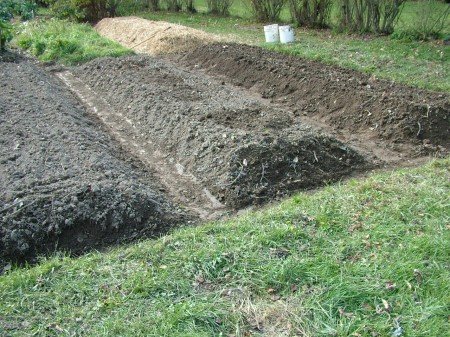
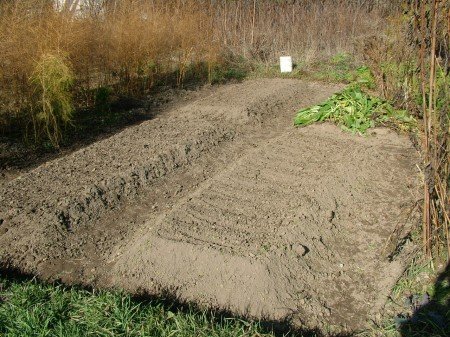
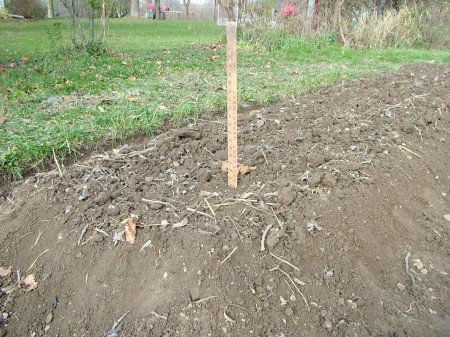
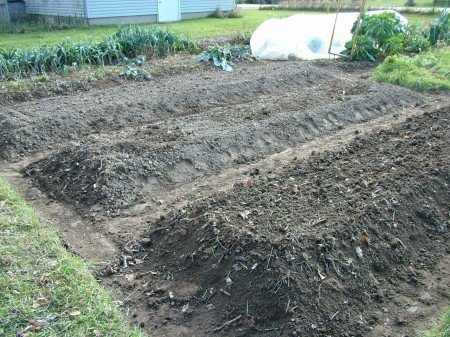

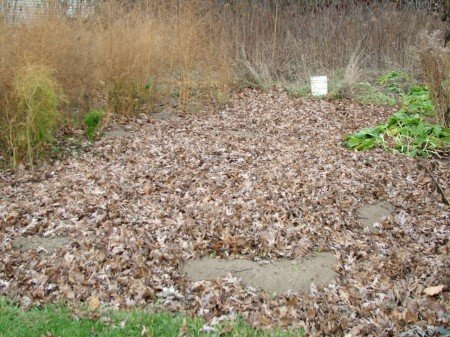
Do you cover the beds with leaves , or do you work them all in . Do you make your beds in spring. I have a large leave pile that I am going to leave sit for the winter so I can get some leaf mulch for spring, Is that a good idea, or should I cover the whole garden with leaves, I have the beds covered right now. The wind took some of the leaves off, should I just keep adding.
Hi Bob. I cover the beds right now as I rake up the leaves from the yard. I don’t try to work them in. A few blow away, but mostly they stay put until Spring. In Spring, I rake them off the beds and into the paths. If I have too many leaves, I make a compost pile in the garden with the extra. The leaves in the paths keep the weeds down and eventually break down into leaf mold and compost. If you have bare spots in the beds it’s not a big deal, but you’ll get more weed emergence in the bare areas. You’ll notice in the spring that the areas covered with leaves are a lot softer than any bare areas
In our area the slugs love the moist leaves in the winter time. How do you handle all the slugs that live in the leaves?
I live on a ridge top in SW Iowa and garden in terraced flat, contour-following beds with 1-2′ drop down to bed and 1-2′ high downslope berms.
I have to incorporate the leaves, grass clippings, corn stover, sawdust, compost and plant waste, to keep them from blowing away.
Nitrogen comes from the use of compost and leguminous covers.
The crop rotation is this: 1. potatoes in multi-row raised beds, 2. same-season lettuce and mixed salad greens, including mustards, kales, collards, chards and Asian greens, 3. beets and carrots, radishes, turnips for greens, 4. fall legunminous covers, 5. Spring radish, carrots, turnips, kales 6. Edamame, beans, lettuces, all types of edible greens, 7. Sweet potatoes 8. Fall turnips, transplanted broccoli, brussels sprouts, beets, carrots, radishes and chards under Winter caterpillar tunnels, 9. Spring salad greens, 10. Sweet kales, collards, chards, spinach, mixed salad greens under Winter caterpillar tunnels, 13. Hairy vetch, white clover and triticale for spring cover 14. Till in cover and rebuild beds, re-establish walks and reshape raised beds, then plant potatoes again, repeat.
This year, I stopped relying totally on plowing with an 1890’s IH 2 bottom plow by a 1972 JD 3020, followed by roto-tilling and now pull a 1920’s JD disc, towing behind a home-made bed shaping box to set up the potato beds every third year.
I, too do not use rows, except for potatoes, corn and sweet potatoes and these are interplanted with buckwheat or clover to maintain soil mositure.
Rebuilding my soil has only been going for 3 years in the terraced beds, but I can see real tilth advantages. All bed maintenance is done by hand. The toughest problem is keeping the Creeping Charly and Henbet from spreading. The white clover helps in this effort.
I’ve not yet had a problem with slugs in the leaves, but I could see that it might be an issue. I do not use the leaves as mulch around any plants. I rake them off the beds after winter and I don’t mulch my plants with leaves. I once lost a tomato crop to slugs mulched with straw. They liked the cool wet conditions under the straw. Slugs don’t like dry soil, so I try to keep the soil clean around the plants. I know that lime will deter slugs and maybe a light dusting of your beds with lime prior to laying leaves down might help. I’m not testing my soil, but I know the leaves are quite acidic and lime is alkaline and slugs don’t like it.
Thanks for the info on spreading before spreading leaves. Would dolomite lime be okay?
Yes. Just about any alkaline material will repel slugs and they don’t like to travel in dry soil conditions or over course, grainy materials, either.
We too have been using this method in our vegetable garden for over 30 years.
We use cover crops, usually a mix of annual rye and field peas, oats etc. The annual rye is inexpensive and germinates quickly which holds down weed germination and potential erosion until the other crops germinates and begins to grow. Have found it much easier to rotate crops, control weeds and keep down the insect pests. We use our leaves in compost, to grow potatoes, mix with builders straw as mulch. Rarely do we have a problem with slugs. We have always used organic methods and tried to plant companion type perennials and shrubs to encourage beneficial insects and birds to visit and nest in the area. We do test about every 3-4 years. Usually the state lab is startled at the balance of our soil. Great suggestion about using lime to control slugs. 🙂